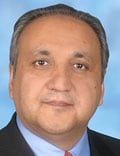A noninvasive enhanced liver fibrosis (ELF) blood test identifies patients with nonalcoholic fatty liver disease (NAFLD) who are at increased risk of advanced fibrosis, according to a new study.
According to the study researchers, when combined with the fibrosis-4 (FIB-4) score the ELF test may be a reliable method that can assess for advanced fibrosis in clinical practice.

Dr Zobair Younossi
Despite the utility of identifying advanced fibrosis in the NAFLD population, significant barriers exist to “risk stratifying patients in clinical practice owing to the need for liver biopsy,” wrote study authors Zobair M. Younossi, MD, of the Inova Health System in Falls Church, Va., and colleagues in JAMA Network Open.
“NASH [nonalcoholic steatohepatitis] can only be diagnosed by biopsy and liver pathology yet validated noninvasive tests that accurately diagnose NASH don’t exist,” said Younossi in an interview. “Developing noninvasive tests to accurately risk stratify patients with significant fibrosis in NASH is highly desirable in clinical practice. A blood test such as ELF can open the opportunity to order this test anywhere in the country.”
The ELF test reflects extracellular matrix metabolism as opposed to tests that assess alterations in hepatic function. The study authors explain that the noninvasive ELF test is a “blood-derived panel of biomarkers consisting of three components: type III procollagen peptide, hyaluronic acid, and tissue inhibitor of metalloproteinase-1.”
To gain a further understanding of the role of ELF in predicting the risk of nonalcoholic steatohepatitis (NASH) in NAFLD, Younossi and colleagues performed a retrospective, cross-sectional analysis of outpatients within a community-based liver clinic from 2001 in 2020. The study cohort included 829 patients (mean age, 53.1 years) with NAFLD, which was characterized by steatosis greater than 5% without any other liver disease or excessive alcohol use.
In the overall study population, the mean FIB-4 score was 1.34. In the 463 patients with liver biopsy, approximately 24.4% presented with bridging fibrosis or cirrhosis. A total of 79 (17.1%) of the 462 patients with transient elastography data presented with liver stiffness results of 9.6 kPa or greater, which according to the researchers was indicative of advanced fibrosis.
Biopsy determined that those with advanced fibrosis in the study had significantly increased ELF scores versus patients without advanced fibrosis (10.1 vs. 8.6, respectively; P <.001). Moreover, patients with advanced fibrosis had significantly greater liver stiffness as determined by transient elastography (10.0 vs. 9.0; P <.001).
In the NAFLD population, the ELF test demonstrated excellent performance in identifying patients with advanced fibrosis, as reflected by an area under the receiver operating characteristic curve of 0.81 (95% confidence interval, 0.77-0.85) for those whose fibrosis was diagnosed by biopsy as well as 0.79 (95% CI, 0.75-0.82) for fibrosis diagnosed by transient elastography. Similar performances of the ELF score were reported among those with NAFLD who were aged 65 years or older (AUROC, 0.74; 95% CI, 0.58-0.87) or patients who had type 2 diabetes (AUROC, 0.78; 95% CI, 0.71-0.84).
The researchers regarded the combination of an ELF score of 7.2 or greater with a FIB-4 score of 0.74 or greater, as indicative of a negative predictive value of 95.1% (95% CI, 91.8%-98.4%) and a sensitivity of 92.5% (95% CI, 87.4%-97.5%). According to the investigators, these values “can reliably rule out advanced fibrosis.”
Additionally, the combination of an ELF score of 9.8 or greater with a FIB-4 score of 2.9 or greater, was associated with a positive predictive value of 95.0% (95% CI, 85.5%-100%) and a specificity of 99.7% (95% CI, 99.1%-100%), suggesting this combination can conversely “be used to rule in advanced fibrosis,” the researchers wrote.
Serologic approaches for predicting the risk of NASH are more widely available and “easier” to use than radiologic approaches, but the former may not be as reliable or accurate as the latter, explained Tibor Krisko, MD, a gastroenterologist at Weill Cornell Medicine and New York-Presbyterian, in an interview. “The choice of which serologic test is utilized is often guided by what is available in a region/practice, what the provider is familiar with, and what a given patient’s insurance covers,” said Krisko, who wasn’t involved in the study.
“The study by Younossi et al. perhaps confirms that ELF alone is unlikely to be the future standard of care, and the authors weave this to a conclusion and strength, highlighting that the combination had excellent accuracy,” commented Krisko. “This is an exciting and important area of research and clinical practice advancement, but all of these serological tests have limitations, such as their lack in liver specificity, their risk of being affected by clearance rate, and the fact that they are not biomarkers but rather surrogate markers.”
Therefore, added Krisko, clinicians should continue to consider each patient’s clinical picture carefully and utilize radiographic methods liberally, particularly when serologic results are deemed ambiguous.
Younossi reported conflicts of interest with several pharmaceutical companies. No funding was reported for the study. Krisko had no relevant conflicts to disclose.
This article originally appeared on MDedge.com, part of the Medscape Professional Network.
Source: Read Full Article
